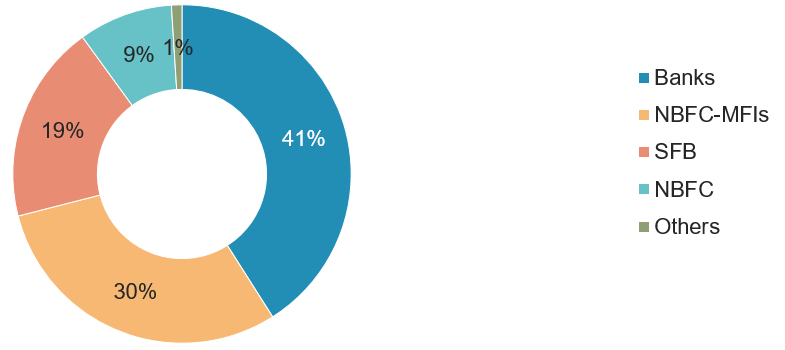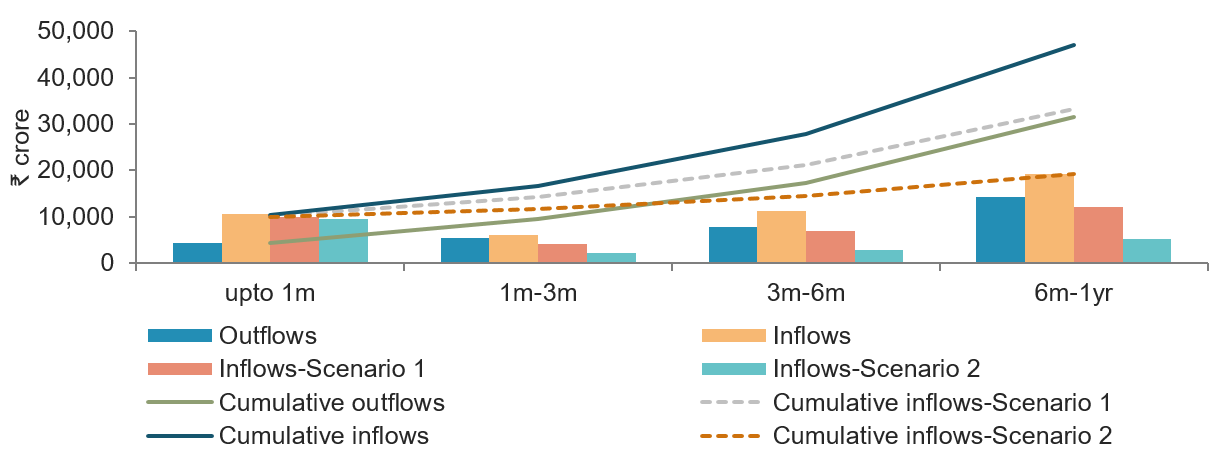Has the Pain Subsided for the Microfinance Industry in India?
Published on 09 Feb, 2021

The COVID-19 pandemic has taken a toll on the microfinance industry in India, with daily-wage workers facing the maximum brunt of the pandemic. Accordingly, the collection efficiency of microfinance lenders plunged during April–May 2020. The pandemic poses a financial risk to MFIs, as credit costs are expected to rise. Two good practices are expected to emerge out of this crisis: improved risk management and digitization for improving operational efficiency.
|
Microfinance recognizes that poor people are remarkable reservoirs of energy and knowledge, posing an untapped opportunity to create markets, bring people in from the margins and give them the tools with which to help themselves. – Kofi Annan |
Introduction to microfinance
Microfinance institutions (MFIs) are non-banking financial companies (NBFCs) registered with the Reserve Bank of India (RBI). These NBFCs offer short-term loans to people at lower interest rates compared with primary lenders. They usually focus on serving people from rural and semi-urban areas who need money urgently for a short time period, usually one to two years.
History of microfinance in India
The microfinance sector emerged from the need to provide easy access to savings and credit facilities to small businesses and entrepreneurs who lack access to banking and related services. Loans to the less affluent sections of the society are often faced by restraints such as lack of security and high operating cost. Microfinance was thus developed as an alternative for providing loans to people having low income, with the goal of realizing financial inclusion and equality. Nobel laureate Muhammad Yunus introduced the concept of microfinance in Bangladesh by launching the "Grameen 80 Bank". NABARD took this idea and launched microfinance schemes in India. With the emergence of informal self-help organizations, microfinance in India began in the 1970s and reported strong growth figures after 1991, owing to the liberalization of the economy and increased lending by private sector entities.

Indian MFI market
In the past decade, microfinance has been growing simultaneously with the Indian economy. The sector has played a key role in providing formal loans to underserved low-income households and micro-, small-, and medium-sized enterprises (MSMEs), thus increasing their contribution to India's overall GDP.
The pie-chart below shows the market share of each peer group in the microfinance industry. Compared with Q2 FY20, the market share of NBFC-MFIs declined by 1%, while that of banks increased by 1%, SFBs increased by 2%, and NBFCs declined by 2% in Q2 FY21. Banks have the highest market share as at the end of September 2020 at 41%, followed by NBFC-MFIs at 30%.
Micro-credit Loan Outstanding across Lenders as of September 30, 2020

Source: MFIN Micrometer, September 2020
At an industry level, as of September 2020, GLP increased to INR2,31,778 crore, from INR2,01,724 crore, up 15% compared with 2QFY20. A total of 10.5 crore clients had outstanding loans, while the number of unique borrowers stood at 5.71 crore. With respect to NBFC-MFIs, the aggregate GLP of MFIs was INR71,147 crore as on September 30, 2020, including owned portfolio of INR57,270 crore and managed portfolio of INR13,878 crore.
Outreach Trend

Source: MFIN Micrometer, September 2020
Loan disbursement is dependent on funds received by the MFIs from lenders, primarily commercial banks. For NBFC-MFIs, in 2QFY21, a loan sum of INR10,617 crore was disbursed through 32.26 lakh accounts. Owing to the pandemic, this is roughly 43% lower than the 2QFY20 disbursements, but slightly higher than that in 1QFY21, indicating progress. During 2QFY21, the average loan sum disbursed per account was INR32,912, up 20% compared with that in the corresponding quarter of the previous financial year.
Disbursement Trend

Source: MFIN Micrometer, September 2020
The loan portfolio is the key income-generating asset recorded in an MFI’s balance sheet. Interest income generally constitutes over 90% of an MFI’s total income. Lending, obviously, is fraught with the inherent risk of repayment default. Therefore, MFIs should maintain a healthy loan portfolio with minimum loan defaults to ensure profitability and financial health. For NBFC-MFIs, Portfolio at Risk (PAR) greater than 30 days as on September 30, 2020 was 2.51%, which weakened from 2.02% in 2QFY20, mainly because of the COVID-19 pandemic-related operational challenges.
PAR Trend

Source: MFIN Micrometer, September 2020
In terms of industry-wide regional distribution of portfolio, in 2QFY21, East and North East India accounted for 40%, South India accounted for 28%, West India accounted for 14%, North India accounted for 11%, and Central India accounted for 7% of the portfolio. Client outreach data in 2QFY21 in various states shows that the outreach in terms of GLP of some major states such as West Bengal and Tamil Nadu was very high compared with their counterparts. Among the top 10 states, West Bengal had the highest average loan outstanding per unique borrower of INR54,641, followed by Assam at INR49,000. Data also suggests that the top 10 states constitute 81.96% of the total industrial GLP.
Portfolio of Top 10 states

Source: MFIN Micrometer, September 2020
The list of top 10 MFIs in terms of loan portfolio as of FY20 is indicated below. Among these, SKDRDP has the largest portfolio, i.e., 11% of the total portfolio of the sector. CreditAccess Grameen, Satin Creditcare, and Spandana are the other major players in this area.
Name of MFI | Gross Loan Portfolio ( crore) | Percentage | |
|---|---|---|---|
1 | Sri Kshethra Dharmasthala Rural Development Project (SKDRDP) | 11,629 | 11% |
2 | CreditAccess Grameen Ltd. | 9,896 | 10% |
3 | Satin Creditcare Network Ltd. | 7,220 | 7% |
4 | Spandana Sphoorty Financial Ltd. | 6,829 | 7% |
5 | Asirvad Microfinance Ltd. | 5,503 | 5% |
6 | Muthoot Microfin Ltd. | 4,932 | 5% |
7 | Arohan Financial Services Ltd. | 4,854 | 5% |
8 | Annapurna Finance Pvt. Ltd | 4,030 | 4% |
9 | Fusion Microfinance Pvt. Ltd. | 3,608 | 4% |
10 | Samasta Microfinance Ltd. | 3,400 | 3% |
Source: Bharat Microfinance Report 2020
Impact of COVID-19 pandemic on microfinance sector in India
The basic characteristic of an NBFC-MFI’s loan portfolio is that loans are mainly unsecured, which made them very vulnerable to systemic risks caused by the COVID-19 pandemic. In contrast, other microfinance lenders had comparatively more diversified portfolios and access to lenders for obtaining last-resort facilities of the RBI, market financing, and low-cost deposits.
The hit to the labor market severely affected low-skilled workers who did not have the option of working from home. Hawkers, small traders, and daily-wage laborers, who constitute the largest share of microfinance borrowers, were the worst hit by the lockdown imposed in March 2020. This category represents about 32% of the total employment, but it suffered around 75% of the financial impact of the lockdown. However, with the gradual lifting of lockdowns, the employment situation improved in the following months, with the overall unemployment rate decreasing to 8.13% in August 2020 from 26.19% in April 2020.
Month-wise Trend in Collection Efficiency

Taking into consideration the difficulty in repaying loans, a substantial proportion of microfinance borrowers availed loan moratorium. In the first week of April 2020, only 30% of the micro loan borrowers had availed the RBI-prescribed moratorium. However, the ratio surged to around 70% by the end of the first week of May 2020. Due to this, recently obtained data indicated a steep fall in the collection efficiency of microfinance securitization pools. The collection efficiency first fell to 83% in March 2020 and then stumbled to a record low of 3% in April 2020. Eventually, collection efficiency recovered to 21% in May 2020 and 58% in June 2020. Compared with microfinance pools, other securitization pools (e.g., housing loans (HLs), loans against property (LAPs), Non-MFI: personal loans, gold loans, and commercial vehicle loans) performed better, with the decline in collection efficiency being less pronounced.
The COVID-19 pandemic presented liquidity risks to NBFC-MFIs. As can be seen from the maturity pattern of liabilities and assets of NBFC-MFIs as on March 31, 2020, individual as well as cumulative time periods showed positive gaps (inflows > outflows). This was due to the fact that customarily, the liabilities of NBFC-MFIs mainly comprise long-term borrowings, while assets comprise short-term loans having high repayment frequency. However, the liquidity profile was affected due to challenges in loan collections and increase in credit delinquencies during the pandemic. Furthermore, the moratorium availed by borrowers affected the inflows. Two different stress scenarios are portrayed: Scenario-1 assumes 40% drop and Scenario-2 assumes 80% drop in loan collections (constant outflows assumed in both scenarios). In Scenario-1, cumulative gaps narrowed, but remained positive across time periods. However, in Scenario-2, cumulative gaps up to 6 months and up to 1 year turned negative, indicating the need for additional funding at an aggregate level.
Structural Liquidity Profile: NBFC-MFIs

Source: RBI, ICRA, MFIN
What lies ahead….
The COVID-19 pandemic is probably the biggest tail risk event since the 2008 financial crisis. Due to disruptions in business operations and supply chain, the probability of loss of jobs and resulting drop in household incomes were high. Accordingly, due to the COVID-19 pandemic, the microfinance sector is expected to face financial risks in the near term. Credit costs for MFIs are expected to increase. ICRA stated that the credit costs for the sector would remain volatile, with an annualized mean level of 1.5–2.0%. The credit cost would differ across cycles and among players, depending on risk management practices. The sector will likely report a return on equity (RoE) of 13–15% in FY21. Furthermore, credit discipline may get affected by disruptions in MFI operations. However, the crisis may also incentivize digitization. Efforts to migrate loan collections to digital platforms may greatly improve operational efficiency and help in minimizing event-based disruptions.
In November 2019, for NBFC-MFIs, the RBI allowed the increase in the maximum indebtedness of a borrower to INR1.25 lakh from INR1.0 lakh earlier. This change could rapidly increase the ticket sizes. While this may help MFIs in significantly lowering operating costs and improving client retention, microlenders such as banks and SFBs, which also serve the same customers, are not covered by these guidelines. Hence, the overleveraging risk would increase and would need to be mitigated through an in-depth review of the debt-servicing ability of borrowers and highly evolved risk management practices on the part of lenders.

